During World War II, the Germans stole priceless cultural treasures from Poland. Churches also fell victim to them. However, some goods were saved from plunder.
Expecting the outbreak of the war, on July 11, 1939 in Pelplin, the bishop of Chełmno Stanisław Okoniewski called a conference of priests from all deaneries of the diocese, where he ordered to deposit works of art and valuable valuables in the bishop's curia. (...) Fearing German robberies, the authorities of the Pelplin diocese decided to remove the most important church treasures from the endangered territories of Poland to a safe place:manuscripts from the Library of the Theological Seminary in Pelplin.
Priceless Gutenberg's Bible
The priests secretly ordered a suitcase from the saddler Gutkowski, in which they intended to take away from Pelplin the two-volume Gutenberg Bible, one of the most valuable cultural treasures in Poland, created between 1452 and 1455 . The Pelplin Bible consisted of 641 large-format cards. Before the war, it was one of forty-five copies of the Gutenberg Bible, the first printed book in the history of the world, that have survived. Its value was estimated at a huge amount - PLN 1,800,000 at that time.
In July 1939, the suitcase was ready. Leather, made to measure, with soft, shock-absorbing cushions inside. The saddler Gutkowski made it according to the dimensions provided by the priests. The authorities of the Pelplin diocese did not take any chances - the Bible was packed immediately. The diocesan conservator and director of the Seminary Library, Father Antoni Liedtke, with a suitcase in one hand and a package containing a 16th-century psalter in the other, left without delay for Warsaw.
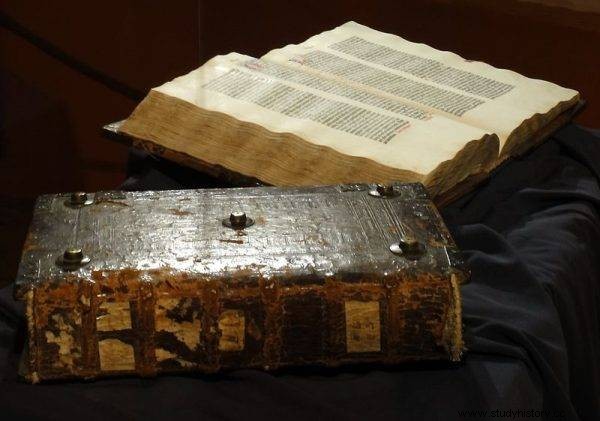
Gutenberg's Bible, one of the most valuable cultural treasures in Poland
Thanks to the efforts of a well-known researcher of old prints, Kazimierz Piekarski, it was possible to obtain permission to deposit the monument in Warsaw. On August 2, 1939, a suitcase with Gutenberg's Bible, along with an attached 16th-century psalter from the same library, was put to rest in the parliamentary assembly of the Bank Gospodarstwa Krajowego in Warsaw . At that time, it was the most modern bank safe in Poland, designed together with the BGK building less than ten years earlier.
Evacuation of cultural property
Soon the most valuable pieces of Polish literature were to be added to the Pelplin deposit in the BGK treasury. On August 5, 1939, the director of the National Library took from a fire-resistant armored cupboard in his office a portfolio with the originals of Chopin's works, P s a ł t e r with fl o r and a ń s k and , K a with a n and a w w and ę t o k r with y s k and e , O b j a w and e n and a w w . B r y g and d y , R o c with n and k w w and ę t o k r with y s k and and eighteen other priceless, oldest Polish manuscripts. Packed in two boxes, the works from the National Library also ended up in the treasury of Bank Gospodarstwa Krajowego.
After the outbreak of the war, the treasures of literature were evacuated along with the bank's property. On September 18, the monuments were transported across the Polish-Romanian border. Eventually, they were transported to France, where they joined the happily evacuated Wawel tapestries. On June 18, 1940, during the defeat of France, the manuscripts and tapestries were left on board the "Chorzów" ship to England. In July 1940, "Batory" transported them to Canada.
Father Thief
Immediately after entering Poland, the Germans began to search for Gutenberg's Bible. During a large-scale investigation, the Gestapo questioned many parish priests in Pomerania. In the first days of the war, the Germans suspected that Polish priests had hidden the Bible near Pelplin. Later, the investigation was extended to Warsaw and Lublin, where, inter alia, Władysław Góral, the bishop of Lublin, was interrogated. In the end, the occupiers sent an arrest warrant across Europe for Father Liedtke, whom they called "Gutenberg's Bible thief". The priest was already in Spain then.
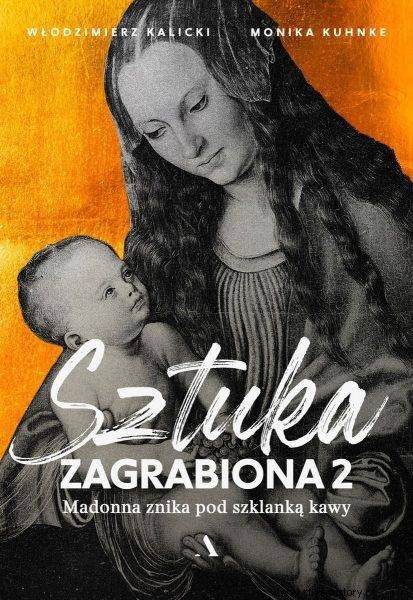
The text is an excerpt from the book by Włodzimierz Kalicki and Monika Kuhnke “Sztuka zagrabiona. Volume 2. Madonna disappears under a glass of coffee ”, which has just been released by Agora publishing house.
In 1945, after the Western powers had recognized the Polish Government of National Unity, Wacław Babinski, MP from the London government in Canada, decided to save the national treasures from Warsaw communists. He had the Wawel tapestries hidden in two Canadian monasteries, while the medieval Szczerbiec coronation sword, Marshal's maces, Gutenberg's Bible and priceless manuscripts were deposited at the Bank of Montreal.
Manuscripts from church collections brought to Canada fortunately survived the war and returned to Poland in the late 1950s.
Polish treasure map
The Church had to hide most of its treasures in the country. The greatest responsibility rested with the Pauline Fathers of Jasna Góra. Remembering the experience of history, the monks took the Treasury from Jasna Góra to Leśna in Podlasie in advance. The Germans never found his trail.
The painting of the Virgin Mary was hidden in the monastery by the Paulines. (...) In 1939 - according to credible, though officially unconfirmed reports - embedded the original of the painting with the Black Madonna into an ordinary table. Another version says that the painting is bricked up. On the altar, the monks placed a copy. Fortunately, this was a redundant precaution. The Germans did not dare to rob the national sanctity of Poles.
At the end of August and September 1939, clandestine work raged in churches, religious houses, and diocesan museums. The clergy and the faithful dug hiding places, bullets, walls, and bricked up hiding places. In the Gniezno cathedral, the churchman Groblewski dismantled the great-value confession of St. Adalbert and hid it in the southern base of the tower, and priests buried the valuable marbles of the cathedral in the basement. Zakrystianin Karłowski from the parish church in Bydgoszcz embedded the most valuable works from the local collections into the columns and pillars of the church . They survived.
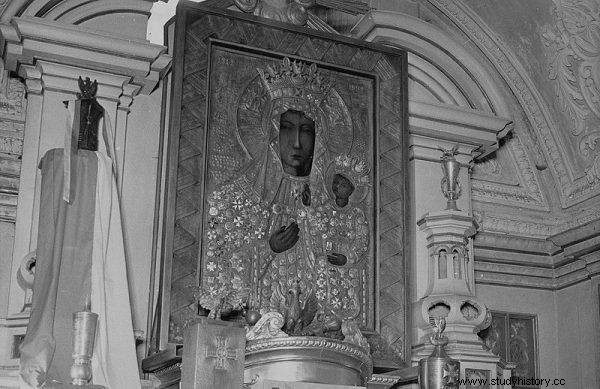
The greatest responsibility rested with the Pauline Fathers of Jasna Góra.
Many hiding places, especially in churches, have been forgotten as a result of the death of the priests and the faithful who took part in their construction. During the renovation of the presbytery in Kartuzy in 1966, two antique goblets and a can were accidentally found hidden in the attic in September 1939. During the renovation in 1970, the farm buildings at the parish church of St. Trinity in Kościerzyna, a precious 16th-century painting Christ on the Cross hidden in the dovecote was found . The parish priest hid it there, rightly fearing confiscation.
Nazi plunder
However, a large part of the treasures hidden by the Church fell into the hands of German robbers. Such was the fate of the treasury of the Poznań cathedral, hidden just before the war in the Dominican monastery in Lublin. Evacuated in 1939 to the monastery in Lubartów, the archives of the Poznań Archdiocese were found by the Nazis in the first days of the occupation. Nine crates with invaluable documents were taken to Berlin. In October 1939, the Germans found and confiscated three old bells from the St. Matthew, buried in the garden of the local Elizabethan Sisters (...).
In the morning of September 1, the pastor of the Church of St. Nicholas in Kalisz, priest Stanisław Zaborowicz heard on the radio the news of the attack of the Third Reich. He woke up priest Franciszek Nowacki and the churchman. Together they took Z from the main altar d j ę c and e with k r with y ż a Rubens. (...) Father Nowacki took the painting to Warsaw on the first train and entrusted it to the director of the National Museum, Stanisław Lorentz.
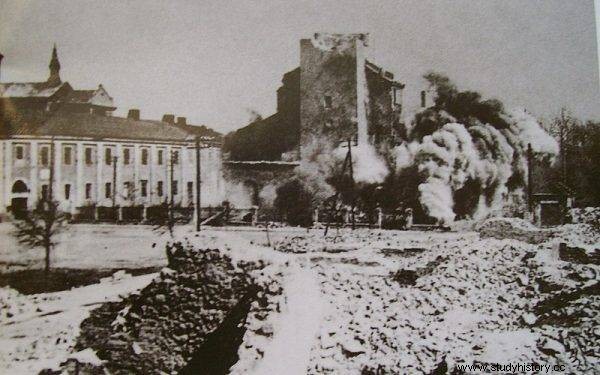
The Germans blew up, among others church of st. Michael in Wieluń
Immediately after the departure of Father Nowacki, Father Zaborowicz, with the help of the churchman, hid chalices, platters and candlesticks of great artistic and historical value in an old hiding place under the floor of the church in Kalisz. A few days after the occupation of Kalisz, the Gestapo arrested both priests from St. Nicholas and the church. They were tortured for days, but none of them revealed where the painting was hidden and the rest of the treasures. Father Zaborowicz was taken to the camp in Radogoszcz, then to Łódź and murdered there. Father Nowacki survived in the German camp until the end of the war.
The painting by Rubens was found in the collection of the National Museum by specialists from Kai Mühlmann's team and confiscated. The Germans took the work back to Kalisz, because the city was incorporated into the Reich. Ultimately, The Descent from the Cross it ended up in the Nazi town hall and luckily was not taken away while escaping from the eastern front (...).
Secure Art Directory
The stolen art was officially to serve the robbers. It was planned that the most outstanding of the stolen works would go to Austria, to Linz. Hitler, who spent his high school years in this city, wanted to build there the most wonderful museum in the world, which was to also include the vast majority of the over five hundred most valuable works stolen from Poland, where the General Government was created, described in the Catalog of Secured Art , that is in Sichergestellte Kunstwerke im Generalgouvernement .
The rest of the so-called The protected monuments from Poland were to be enriched for all times by other museums and institutions of the Third Reich. The church treasures also found their way to the German collections. Coffin paintings of the Wejher family, taken from the monastery in Wejherowo, were deposited in Berlin's Altes Museum. Later they ended up in the German museum in Wejherowo. The scientific museum in Berlin seized the chalice from Płock, and the confiscated rings of the Płock bishops went to the safes of the Berlin Reichskasse.
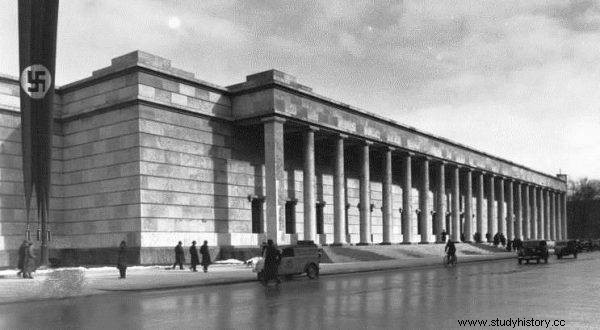
It was planned that the most outstanding of the stolen works would go to Austria, to Linz.
Churches in the territories incorporated into the Third Reich, which were massively closed by the occupiers in 1941, the Nazi authorities plundered almost to the bare walls. Even the German cardinal Adolf Bertram from Wrocław, in a letter of April 14, 1941 to Pope Pius XII, lamented the plundering of these churches and asked for intervention with the authorities of the Third Reich.
Items considered by German experts to be of inferior value, mainly utility silver, were melted down by the occupiers or sold in pawnshops. On August 15, 1940, thirty-three boxes of church silver were sent from Poznań to Berlin pawnshops. In Poznań, collections of Polish paintings from the Wielkopolska Museum were sold to the local Germans as worthless for the official collections . Even ordinary cutlery was not passed through (…).
A gift from Hitler
Immediately after the fall of France, Hitler was very anxious to draw Spain into the war. He primarily meant naval bases for the Atlantic operations of German submarines and a joint attack on the British base in Gibraltar. (…) But the generalissimo Franco deceived Hitler. He made impossible financial demands, demanded such large supplies of strategic raw materials that the German economy would not be able to withstand it (...) .
Hitler decided to win the sympathy of the arch-Catholic Spaniards and sent them three wagons of religious gifts:valuable, antique church utensils, sculptures, and pictures of saints. Officially, these were gifts from Bishop Wilhelm Berning of Osnabrück and Monsignor Benedikt Kreutz, president of the German Caritas. The German embassy organized a lavish gift exhibition at Madrid's Círculo de Bellas Artes, the Center for Fine Arts. The exhibition took up three floors of this monumental building (...).
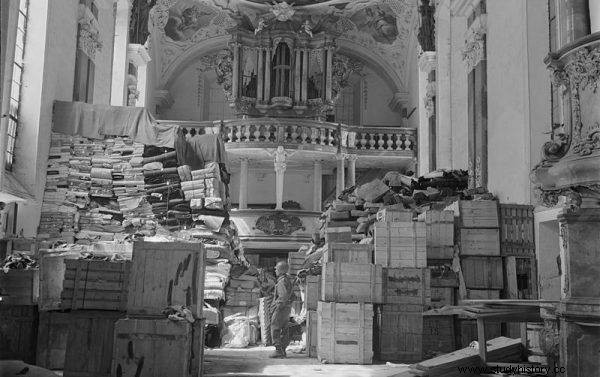
Hitler decided to win the sympathy of the arch-Catholic Spaniards and sent them three wagons of religious gifts (pictorial photo)
Each of the exhibits had a certificate with the German name of the parish, diocese or monastery from which it comes, but news spread quickly that the Germans donated goods looted to Polish and Czech Catholics. (...) Monsignor Cicognani wrote to the Italian Cardinal Luigi Maglione that the Germans sent a total of twenty-seven tons of gifts (...). The exhibition was visited by the Bishop of Chełmno Stanisław Wojciech Okoniewski and his chaplain, priest Świtalski. Father Świtalski wrote later in a letter:
It must be admitted that the exhibition was impressive and it fulfilled its propaganda task. There were indeed words of indignation, such as for example that they should give these items back to the countries where they robbed them, but these were isolated cases. (…) I am convinced that our chasubles were there, but unfortunately how can we prove it to them?
It was not really possible to prove. The stolen church goods remained in Spain. Franco accepted the gifts of the robbery, but did not join the war.
Source:
The text is an excerpt from the book by Włodzimierz Kalicki and Monika Kuhnke “Sztuka zagrabiona. Volume 2. Madonna disappears under a glass of coffee ”, which has just been released by Agora publishing house.
